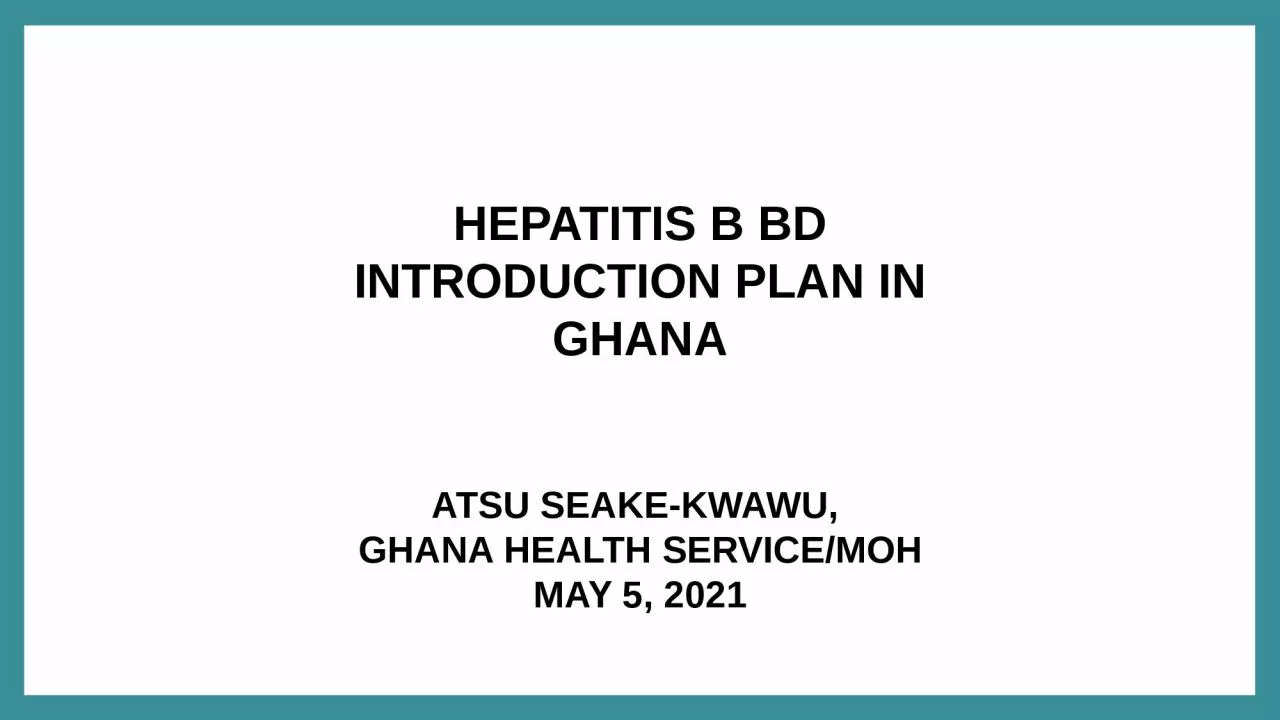

PLAN IN GHANA ATSU SEAKEKWAWU GHANA HEALTH SERVICEMOH MAY 5 2021 Ghana Background Population 30955204 GSS 2020 est CBR 28826 births per 1000 Expected births 2020 892314 ID: 933893
Download Presentation The PPT/PDF document "HEPATITIS B BD INTRODUCTION" is the property of its rightful owner. Permission is granted to download and print the materials on this web site for personal, non-commercial use only, and to display it on your personal computer provided you do not modify the materials and that you retain all copyright notices contained in the materials. By downloading content from our website, you accept the terms of this agreement.
Slide1
HEPATITIS B BD INTRODUCTION
PLAN IN
GHANA
ATSU SEAKE-KWAWU,
GHANA HEALTH SERVICE/MOH
MAY 5, 2021
Slide2Ghana Background
Population: 30,955,204 (GSS, 2020
est)CBR: 28.826 births per 1000Expected births (2020): 892,314Women’s healthAt least one ANC visit-97%At least 4 ANC visits-87%Deliver in health facility-73%GSS.DHS.2014
Slide3Ghana-BCG, OPV0 and Penta3 coverage trends
Slide4Estimated burden of Hepatitis B using HBsAg prevalence
General population- 12.3% (Ofori-
Asenso and Agyeman, 2016)Pregnant women-Unknown (but 12% median prevalence estimated of 4 hospital- based studies published before 2014)Subject of ongoing CDC-funded Seroprevalence studyChildren <5 years- 0.64% (0.50%-0.80%) Modelled data IHME, 2019
Ofori-
Asenso
, R. and A.A. Agyeman,
Hepatitis B in Ghana: a systematic review & meta-analysis of prevalence studies (1995-2015).
BMC Infect Dis, 2016.
16
: p. 130.
Breakwell, L., et al.,
The status of hepatitis B control in the African region.
Pan
Afr
Med J, 2017.
27
(Suppl 3): p. 17.
Slide5Current Process for the
HepB
BD IntroductionHep B-BD described as potential new vaccine in cMYP 2015-2019 for introduction in 2017NITAG required evidence of disease burden before introductionIn 2020 CDC/WHO/GHS/NMIMR developed protocol to estimate the seroprevalence of hepatitis B among pregnant women using 2019 HIV Sentinel survey samplesNecessary approvals have been obtained for study to startEvidence obtained will be presented to NITAG for evaluation
Hepatitis
Programme
will disseminate the results to wide stakeholder platforms to build support and expectation for BD
Once NITAG approves, application will be submitted by EPI to GAVI to support Government of Ghana to introduce BD
Government of Ghana.cMYP.2014
Slide6Hepatitis B Screening and Prevention Policy
Ghana New Maternal and Child Health Record
Slide7Hepatitis B Screening and Prevention Policy
Policy on preventing mother to child transmission of HBV is incorporated into RMNCAH policy in principle
HBsAg screening of pregnant women on-going but not reportedMultiple rapid test kits in use of doubtful approval statusNational Programme has not yet developed Testing policy/algorithm Treatment guidelines for infected pregnant women are yet to be updated to reflect current WHO recommendationsInterventions to prevent MTCT_HBV are not yet on public offerImported HBIG and Birth dose HB are available in privately in some cities
Slide8Challenges Facing The Hepatitis B Birth Dose
Programme
Most important challenge now is obtaining early data for NITAG decisionOther foreseen challenges includeOrienting midwives to accept birth dose vaccinator role within labour wards with all its accompanying responsibilities Documentation Accessing EPI cold chain/ maintenanceReportingReaching newborns born outside health facilities within 24 hoursEarly information flow Availability of staff to vaccinate at homeAppropriate transport means availability at time of need
Slide9Opportunities For Hepatitis B BD Introduction
Research TA is available from CDC and WHO for evidence generation
A second study on Risk of Mother to Child Transmission of Hep B has been submitted for ethical reviewFunding has been secured for both studies through CDCNational cold chain capacity in every districtMidwives already used to Vitamin A administration within 72 hoursMidwives already administering ARV prophylaxis to HIV-exposed newbornsDecentralized service delivery with nurses placed within communities (CHPS zones)
Slide10THANK YOU